I. Some Art Context
I have so much to show you.
This is the first painting I ever saw by Rigoberto Gonzalez.
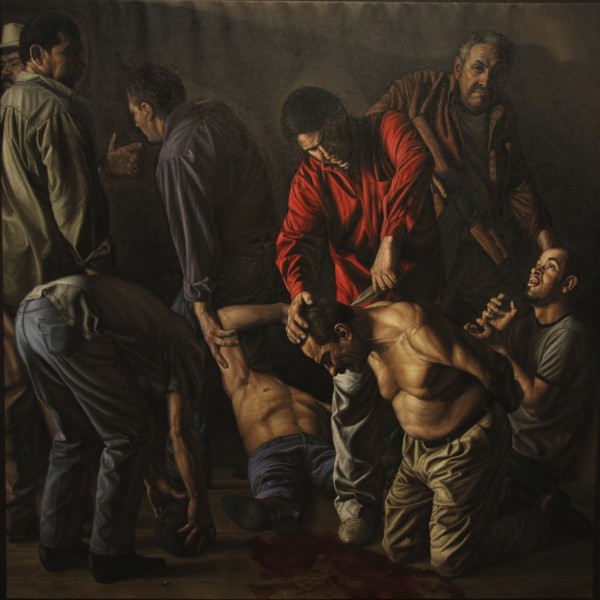
Rigoberto Gonzalez, "The Zetas Cartel Beheading Their Rivals (Se Los Cargo La Chingada)" Oil on linen, 7' x 7'
It appeared in the Virginia Rutledge-curated Texas Biennial show of 2011, and it stopped me cold. The marriage of subject matter and technique felt shockingly fresh. This is a hell of an accomplishment; I was already familiar with the horrors of the cartel war via all media. Also, I was long aware of the contemporary resurgence of figurative painting, particularly figurative painting with Baroque/Old Masters/Flemish flourishes.
— e.g., John Currin
Mark Ryden
As well as Julie Heffernan, Mark Dennis, Lisa Yuskavige.
I’d come to view this historical-device-meets-postmodern-eye business skeptically. For one thing, I was front-loaded with John Currin’s self-conscious and deliberately provocative depictions of women. Outrageously buxom, Mannerist softcore, and a series he described as “paintings of old women at the end of their cycle of sexual potential … between the object of desire and the object of loathing.” This is a mighty spout of manipulative bullshit, but still, Currin can sure turn out evanescent, layered pigment. Even when he later admitted that “I meant [the above description] to sound mean. And I meant it to sound harsh,” there’s no arguing he can lay on the impasto. I’m weary of the Currin baggage, though. There’s just no way to unload it.
Other paintings in this neo-figuralist genre feel cryptic and airless and cynical, and don’t prompt me to ruminate on any kind of “why.” Meat. Baby-faced cherubs doing disturbing stuff of one kind or another. Scary children who look like grotesque Cranach the Elder penitents lighting things on fire. More meat. Boobies. Scary clowns. Bad artist statements.
On the other end of the spectrum, I often see works of social protest which elicit compassion by intention, but whose execution falls exasperatingly short of visual interest. Jennie Ash, the exhibitions manager at The Art League of Houston, said to me recently, “sometimes people don’t realize that by not showing them, I’m doing them a favor. So often, I see work and hope the artist progresses, and I think ‘if only the actual painting were better.'”
I knew exactly what she meant. And to some, this comes off as patronizing. But very often when I decline to review a particular artist or exhibition, particularly one that addresses current political or social themes — like feminism, say — it’s because I can’t just give the work a pass. It’s not enough for me to agree with the sentiment. And, in a way, foregrounding your work’s politics while neglecting technique and composition puts any critic, whatever her politics, at a dialectic disadvantage. Whether or not you’re wearing your heart on your sleeve, you’re hedging your bets. The dare is: “You’d better agree with this, or else.” Social justice schtick is armor, in the same way Currin’s flawless technique schtick is armor.
All this exegesis is leading back to Rigoberto Gonzalez, I swear to God.
II. Encountering a Gonzalez in person
As I stood there in the Texas Biennial Show, looking at “Se Los Cargo La Chingada,” I was met with horror and grandeur and deep sorrow. It was a very strong exhibition, a majority of whose works were excellent, and demonstrated disparate current trends and movements in image-making. But this painting had an urgent, complicated and absolutely contemporary story to tell.
“Se Los Cargo La Chingada” is horrific, strongly allegorical and yet, miracle of miracles, effectively communicative. In an art world so littered by half-intent and deliberately obfuscated meaning, where ambiguity and irony have become a kind of burlesque, this painting presented an unapologetic earnestness with zero naiveté. How is that even possible? I looked and looked at it. I looked at other work, then came back to look at it again. Later I read the Biennial catalogue; I’d heard of the guy, and had even seen a very brief profile of him and his work posted by somebody on Facebook. Before writing the review, I Internet-researched the hell out of Rigoberto Gonzalez, and turned up very, very little, and some of my facts were wrong or outdated. I thought he lived in San Juan, it turned out he lives in Harlingen. I briefly had him confused with another artist named Rigoberto Gonzalez. What amazed me was what I didn’t find — not many published reviews of his work, no long-form interviews.
Rigoberto Gonzalez’s CV is so far outstripped by his mastery that it gives me crazy brain.
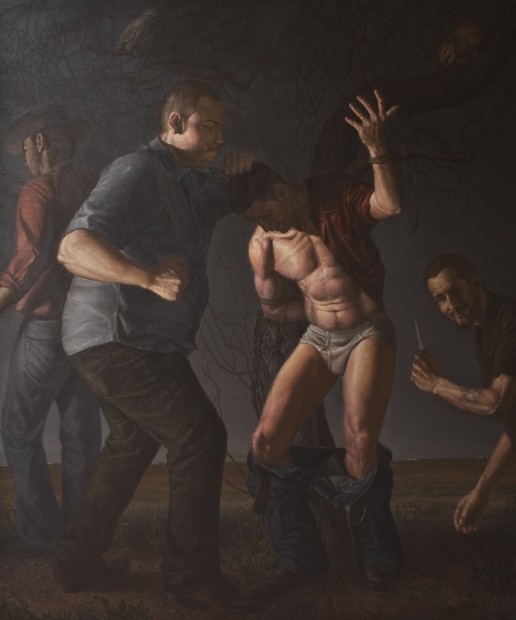
"Contrabando y traicion (Contraband and treason)" Oil on linen 6' x 7' (also the title of a corrido by Los Tigres del Norte)
The entirety of the press articles he cites on his website are local; items in The Monitor (which serves the whole Rio Grande Valley), The Brownsville Herald, The Valley Morning Star.
And that’s the quandary of being an artist in Harlingen, Texas.
South Texas arts writing is the sound of one hand clapping. It’s usually the hand of Nancy Moyer, former chair of the art department at UT Pan-American and a regular contributor to The Monitor. She’s doing as much as she can, and readily admits it isn’t enough. She’s the lone arts writer. And press is an undervalued but irreplaceable currency for a working artist. Good press, or even interesting bad press, establishes a reputation beyond the local (particularly important when the local is extremely remote from most culture centers), opens doors to further exhibitions, artist residencies, graduate programs; and in an absurd catch-22, provides the imprimatur for more press. That’s how the machine works. Art press reads other art press. They/we don’t generally read The Brownsville Herald. Getting coverage of your work is like getting an Actors Equity card, which requires stage work in productions so often already cast with Equity actors.
After my review came out, I spoke to Glasstire about doing a studio visit with Gonzalez, and they were enthused and encouraging. I ruminated. The whole conundrum of covering South Texas confounded me. I tried to figure out the sheer logistics of traveling there. For one thing, I make very little money. And it takes about five hours to get to the population centers of the Rio Grande Valley, meaning you can’t do it in a day. You have to spend the night somewhere, and eat, and buy gas and survive the experiment, making enough time for it that other paid work has to slow down.
But I felt that where there’s a Rigoberto Gonzalez, there must be other under-reported talents, and I wanted to see their work as well as his. Add to that my identification as a San Antonian, the attendant chip-on-the-shoulder feeling like the rest of the country could care less about us even though we’re at the forefront of what’s called the (re-) “Latinization of America.” I wanted to sate my curiosity about contemporary artists in the face of the border politics and nightmares. But I knew I couldn’t expect any publication in the current arts-writing climate to fund some nebulous fact-finding trip all over South Texas in search of stuff that may or may not be happening there. Not in this economy. So I hired me. I goaded myself into raising money to put a tour together and get down there to meet not only Gonzalez, but anybody else I could find. Hence the Chupacabrona Tour. It all started with looking at that painting.
Not this one, the other one, at the top. This one, along with other paintings, I’d only seen online. And big Baroque canvases just don’t translate very well to jpegs.
III. Encountering Gonzalez in Harlingen
Thank God for the Internets. Since Gonzalez had a website with his e-mail address on it, I e-mailed him this fall. It only struck me afterwards how weird that was. Would he mind if I, a complete stranger and out of nowhere, came to look at his stuff and ask a lot of questions, probably for a Houston website but who knows? He was politely OK with it. He was generous, even, offering me a place to stay in Harlingen with him and his wife Adina, and their baby son Emiliano. But he didn’t effuse or self-explain or respond with surprise, as some artists I’d contacted had. He merely consented.
When I’d gotten my Chupacabrona Tour grant and was making actual plans, I e-mailed Gonzalez again, in February. He suggested I wait and come see his upcoming show in March at the Art League of Houston. I don’t know how, but the aforementioned Jennie Ash had gotten wind of my interest, and had already e-mailed me to invite me to participate in a panel discussion about his work. We Skyped; Ash, like me, had encountered Gonzalez’s work on the Internet, getting to his website from a links section of another artist’s website. Like me, she does a ton of Internet research, trying to find artists. She’s only been with the Art League of Houston for six months. She’s trying to rev up the curatorial end of the organization.
By the end of the Skyping, I had become the moderator of a panel discussion on March 12.
After a brief “I’m-a-fraud” panic, I emailed Gonzalez again, suggesting I come visit Harlingen and interview him, and then go to Houston, too. Artist-at-home, then artist-at-exhibition. Plus, I’d already booked a motel room for the night before I was to meet up with him and his family and made arrangements to meet up with a group of McAllen artists the next day.
So on February 24, I made the fourth in an ongoing series of trips to the Rio Grande Valley. I got to the RGV late, around 11 p.m. I drove the last hour and a half or so in near-complete blackness, unwisely listening to the audiobook of Max Brooks’ World War Z. The motel in Harlingen, owned by a cheerful Indian couple, was a nightmare scenario of subconscious-scorching proportions. In one of my earlier trips, I stayed in a motel room in McAllen about which I Facebook-posted that I was pretty sure I was going to be murdered any minute.
This motel was so much worse.
But that’s another story for another time. Motel-landia.
Here’s what the door looked like, though:
The next morning, I slunk out of the motel and had holed up in a Starbucks, where a barista fronted me the 38 cents I lacked for the largest possible cup of coffee. Then, bolstered by kindness and caffeine, I spoke to Rigoberto Gonzalez by phone. We agreed to meet at his new studio, which occupied a nearby storefront. He beat me there, and waited on the sidewalk as I unfolded my jacked-up, sleep-deprived self from my filthy, dented Ford Focus, my hair askew and my eyes road-glazed.
And as is so often the case when I’m both tired and about to interview somebody, I was noisy as a jackass, all hollering hellos across the street at the top of my voice. I sometimes behave in this abominable way so as to put the interview subject at ease, and it usually works; if I’m this much of a blaring dork, they may as well relax. I think they figure they couldn’t sound nuttier than I do. They let their guard down.
Rigoberto Gonzalez is self-possessed, stoic in affect, slightly formal, almost courtly. His conversation is thoughtful and measured.
Here’s a short video of him.
He’s not one for nervous laughter, or inane small talk. In the audio-recording of what was to be a three-hour interview, he sounds sane all the way through — confident, supremely adult, cerebral, impassioned but pragmatic. Whereas in the initial few minutes, I sound like a cross between Wayland Flowers’ Madame and a crazed cast member of “Freaks & Geeks.” Luckily, I start speaking like a reasonable professional by about thirty minutes into it.
We discuss his process. He tells me he developed his method of painting through trying to figure out, mechanically, how masters like Jusepe de Ribera and Caravaggio built their pictures.
“You’re reverse-engineering from Caravaggio?” I ask.
He laughs, for the first time.
“That seems kind of — sounds a little—”
“Presumptuous?”
“Pompous, right. Self-aggrandizing. But actually I had to [develop a painting technique] on my own. I eventually began to map [the picture plane] using this grid, with a lot of underdrawing. You read research on a painting by Da Vinci or somebody, and they have the technology to see how much under-drawing and under-painting he did on a certain canvas, and that’s helpful to know, but it still doesn’t describe what he did first, what he did next, you have to guess based on studies, little bits of information, evidence almost.”
IV. Gonzalez differs with the Contemporary Art World in Several Noticeable Ways
Gonzalez notes, “There’s a book about Da Vinci, and within the first five pages or something, it tells you that in such and such a year, he was arrested for sodomy with a group of other young men…So before they get to anything else, his sodomy legal case. So much art gets sexualized in interpretation, now, hundreds of years after it was made, [because of the] obsession contemporary critics have with sex. Particularly the Baroque period, late Renaissance — art historians read things into [Da Vinci’s oeuvre] based on their own projections.”
“There’s a theory that the Mona Lisa is a self-portrait of Da Vinci in drag,” I say.
“Based on what?”
“I don’t know,” I admit. “I’ve just heard it somewhere.”
“OK, so that’s a pet theory of somebody. But…to take one of the greatest minds in history and reduce the accomplishments of this person to ‘he was a pervert,’ it trivializes him. You’re gay, you’re not gay, whatever your sexual situation is, it doesn’t make up your whole identity.”
“For Queer artists, though,” I say, ” establishing their identity as a gay person is central to their self-expression.”
“I understand that. But I don’t think Da Vinci or Caravaggio or other artists of the Baroque period thought of themselves as gay artists. Whoever they slept with or whatever — it affected their individual life of course, but art is about more than just an individual’s private life. Sublimation in art is a real thing. And we’ve got to remember not to look at their lives and their work through our generation’s bias. They may have been homosexual, but that’s not all they are. That particular reading leaves a lot out.”
We talk about the art-historical advantages of being brought up Catholic, as we both were; the ritual, the traditions, the early access to a host of saints and symbols. We talk about art as spiritual allegory, and the role of Baroque art as a Catholic Church-supported aesthetic reaction to the austerity of the Protestant Reformation.
“One of the kids I was with [in graduate school] used to refer to images of Christ as ‘the hanging guy on the Cross,'” he says.
“He didn’t have any religious training?”
“No, he did.” Gonzalez spreads his hands in a “who knows?” gesture. “He was Christian fundamentalist.”
“It makes a kind of sense that the fundamentalist guy wouldn’t have that immediate connection with a crucifixion scene,” I propose. “Catholic art at that Baroque period tended to be allegorical, but the hardline Protestant attitude towards that is that it’s idolatry,” I say. “Some of the artistic tradition in Catholicism comes from the necessity of illustrating Christian precepts to a pre-literate audience.”
Gonzalez tilts his head, leans in.
“Why do you think that?” he asks pointedly, then stops himself. “Actually, I know why you think that. That’s the attitude of contemporary art [towards] pictorial painting. ‘Religious subjects made into pictures easy for even illiterate peasants to understand.'”
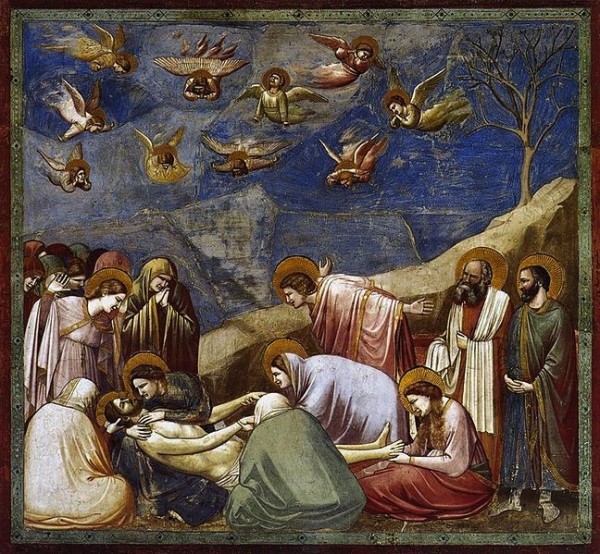
"Look, dummies, they killed Jesus and it was sad. GET IT?" Giotto's "Lamentation (the Mourning of Christ)"
I protest, citing the monasteries in Ireland where texts were kept safe by a literate priestly caste, but in churches, doctrines were made visual, as an educational assist to faith.
“What about the Book of Kells?” Gonzalez asks.
What about it?
“An illuminated manuscript, that’s a perfect example of how pictures aren’t a substitute for language, they are a language, the monks who made the Book of Kells used visual language written into the Gospels. so, was this book made for illiterates, so that they can look at the pictures of dragons and animals?”
“No, but I’m guessing that a lot of people in Ireland in the 9th century couldn’t read.”
He sighs. “But the artists who made that book could.”
He thinks for a moment, and continues.
“To me, this attitude is a mistake. It wasn’t like some painters were hired to train a bunch of ignorant people. The artists, and the audience for [devotional Baroque] work, it included some of the most brilliant minds of their time. They weren’t underestimating their audience. We are underestimating them. It’s a problem of [text becoming] the ultimate kind of intellectual product. Text is more abstract than visual representation, and…maybe less visceral, is another way to put it. Abstraction has become a way of relating to text, and getting around representation. Text is a term used to describe everything now, all the postmodern writings talk really vaguely about this idea of ‘text.’ An installation is a text, wall art is…primitive, or something.”
Another person might have rolled his eyes upon saying this. Gonzalez doesn’t. He’s serious, but not dismissive, and not defensive, exactly. Just means what he means.
“The Baroque painters, and before [the Baroque period], [painters] were communicating with other artists and philosophers and poets, too, and the heads of the Church, who — there were certainly bad ones, like certain Popes” — here he laughs again — “but also scholars in other disciplines. We have to remember that they didn’t know what we know. They had to discover ways of seeing something; perspective is a scientific experiment, [it is] optic science. It wasn’t automatic.”
He cites Perspectiva pictorum et architectorum, Andrea Pozzo‘s two-volume treatise (published in 1693 and 1698) which advises on perspectival technique based, in part, on experimentation with trompe l’oeil in church decoration, and proposing theoretical set design.
“Architecture, visual art, even the theater, it all evolved together. Now everything is so specialized.”
I remark on something I’ve thought about a lot, particularly since reading this article, “So you wanna be an artist. A successful artist.” on Glasstire by Christina Rees, in which she advises, “Retain a healthy sense of absurdity. Accept that you will likely be funded by the buying habits of Republicans (because they have the money).”
“Do you think abstraction, seemingly devoid of subject matter, is an easier ‘sell?'”
“Yeah, I think so. Minimalism, [the reduction of] an object to some component, this can be beautiful, but obviously it’s not gonna be controversial. It doesn’t ask the viewer, or the owner, to…” He thinks.
“I know my work is hard to live with. I don’t have any of my work at my house, where I live, where my child lives. A friend of mine, Dr. Brown, has some pieces in his collection. But really, I make these to be public. I think they’re museum pieces. I want them to be as accessible as possible.”
Accessible conceptually, or physically?
“Both. I want people to get to see this message, wherever it is. But also, I paint so that if you do know about art history and theory and stuff, you can apply it, or find it. But it’s not necessary. I want any viewer to be able to connect. [The contemporary art world] is too out of touch with people who aren’t a part of that world. There’s too much distance, art talking to art about art. Art is communication. All the tricks of technique should go towards that, not just to be conceptual and opaque.
“They never teach you what you want to know,” Gonzalez muses, “they” being his college- and graduate-school studio instructors. “I wanted to learn how these Baroque paintings were made. Instead, you’re told that pictorial representation was only to represent religious symbols for illiterate viewers. It’s a way to denigrate narrative work; that it’s somehow less sophisticated and meant to preach to the ignorant, that it’s literal and not conceptual. But all great art is “conceptual.” I’ve got some problems with the trends of contemporary art, but my work is absolutely contemporary. This”— here he gestures to the work-in-progress, a vast Rio Grande Valley landscape with people fearfully crossing the river —”is happening right now. Half an hour away.”
Rigoberto Gonzalez is a practicing Catholic. I am not. He asks me at one point, “with Joan of Arc, St. Catherine of Siena, Sorjuana — why is it that feminists are so angry at the Church?” I can tell he does not mean this as a provocation. He actually wonders.
I enumerate my issues as a feminist; the lack of female ordination, the precepts that keep women relegated to lower status, the absurd code of sexual behavior especially given the systemic propagation of sexual abuse that’s still coming to light; how could such an institution be taken seriously as a moral authority?
Gonzalez listens. He thinks. He counters, “It’s a 2,000-year-old institution. It moves much slower than the [culture at large] does, and like in any profession — plumbers, teachers, whatever — a certain percentage are going to be not just not good, but can be terrible.”
I re-iterate my outrage at the sexual abuse scandals.
“People with power mis-use it.,” he says. “There are terrible forces inside humanity. But [the Catholic Church] is a system that comes in contact with the divine, the light and dark, that contrast in human beings. The light and dark in Baroque painting is about that. Every person involved is not-perfect, has light and dark. Persons, institutions, religions, nations.”
He explains to me that while in college and grad school, like so many university students, he lost his faith. He was an avid existentialist, and a pissed-off one. He followed along the path of rational questioning that at first blush, seems to obliterate faith for good. In his studio, leaned against a wall, is a representation of Gonzalez’s atheist period.
“I thought of it as an anti-Crucifixion. An atheist crucifixion, that’s what I thought of it. But of course, like all atheists…I was obsessed with God.”
So he made his peace. But he’s no Biblical literalist, and no fan of the Christian Right or fundamentalism in general.
When I bring up Church doctrine on contraception again, Gonzalez says, “any passage [that was originally written] in Hebrew, then translated into Greek, [then into] Latin, then into English, then into American English, I don’t think you can know what the original meaning was, not in a word-for-word manner. People used the Bible as a justification for slavery, and use it to justify gaining material things…to me, that’s sin. There’s no justification for that.”
He lightens up a little, adds “I don’t believe you can interpret words in whatever version of the Bible and [apply that to] birth control. If Jesus was around, my interpretation would be that he’d be out there distributing birth control, that he’d think it was a great thing, it gives more freedom.”
We both laugh. The religious dialogue de-intensifies.
I observe (hardly an original stance) that Jesus talked a lot about the poor, the oppressed, he washed feet, he offered free health care.
Gonzalez grins, shrugs. “I think Jesus was…” he pauses slightly, then goes for it— “a socialist.”
I ask, “How would you answer the accusation that your work has a leftist political agenda?”
Gonzalez doesn’t hesitate. It’s not a hypothetical question.
“That’s accurate. As much as I have Baroque influence my work, I am also social realist. I do have a political agenda, and I’m not apologizing for it.”
To wit: As a child, Gonzalez’s favorite superhero was Spiderman.
Why?
“He was a real person, and lived in a real city.”
On the audio recording I say, “wait, Gotham…?”
“No, that’s Batman. And Superman lived in Metropolis. Only Spiderman identified the actual city as New York, which is a real place.”
I’m laughing. Gonzalez isn’t, but seems to enjoy pointing this out, as though this were formative information — and clearly it was formative. Or prophetic.
“Also, Clark Kent was an alien from another planet,” he goes on, “and Bruce Wayne, the Batman guy, was a millionaire. They weren’t regular people. Peter Parker was just a teenager. He was alienated, and had to hold this secret, and his life changed.”
I stop laughing.
“Wait,” I say. “Doesn’t he get bit by a radioactive spider, though?”
Gonzalez finally lets out a chuckle, admits “he did,” then adds quickly, “but that wasn’t his fault!”
For Part II, click here.
____________
For eight years in New York City, Sarah Fisch defended Texas as the home of muchos smartypantses, artists, thinkers and other people who aren’t, for example, Tom deLay. New Yorkers remained skeptical. After she graduated from The New School, Fisch migrated back to San Antonio in ’08. She has worked as the arts editor at San Antonio’s altweekly The San Antonio Current and the arts and culture staff writer at Plaza de Armas. Furthermore, Sarah Fisch (whose last name is pronounced “fish”) is the 2010 San Antonio Artist Foundation Grant winner for Literary Arts for a forthcoming book of SATX-based short fiction, and was a national Endowment for the Arts / USC Annenberg / Getty Arts Journalism Program Fellow. She’s a children’s book writer, a stand-up comic and also a sound artist, which are conveniently broad categories.



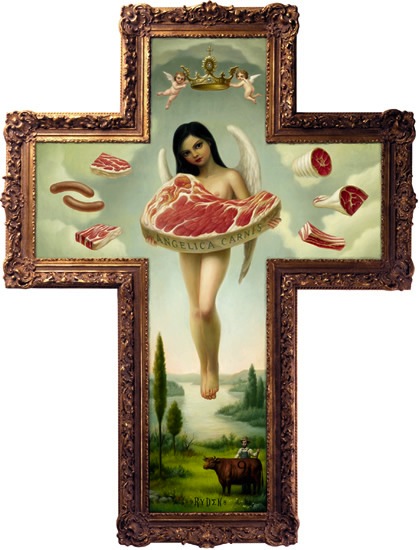
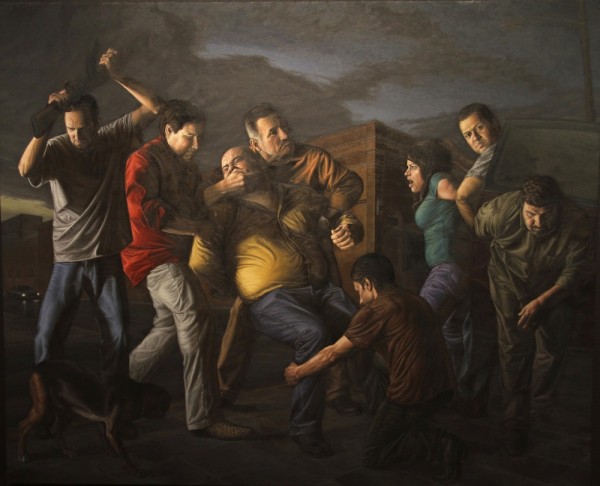

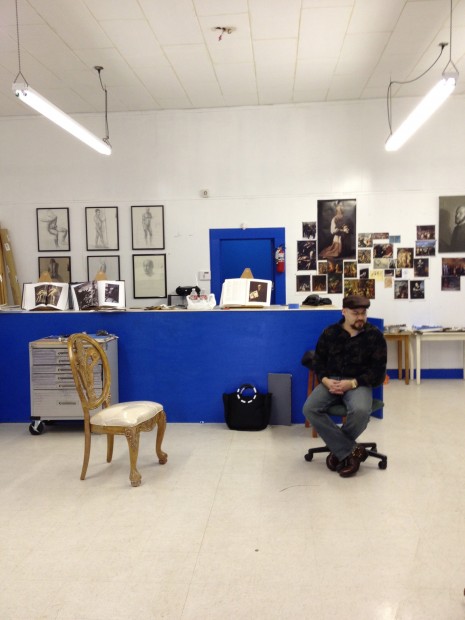
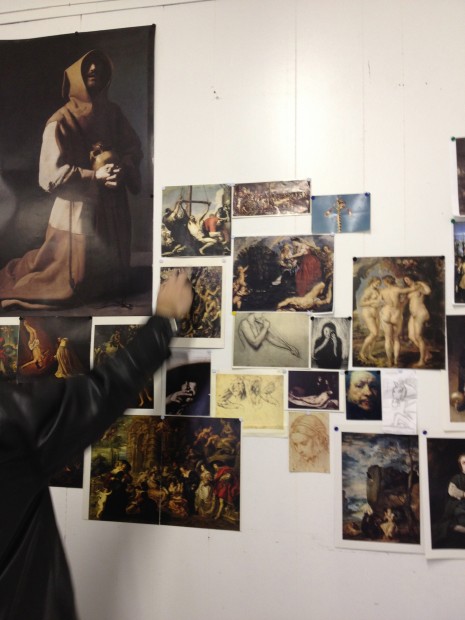
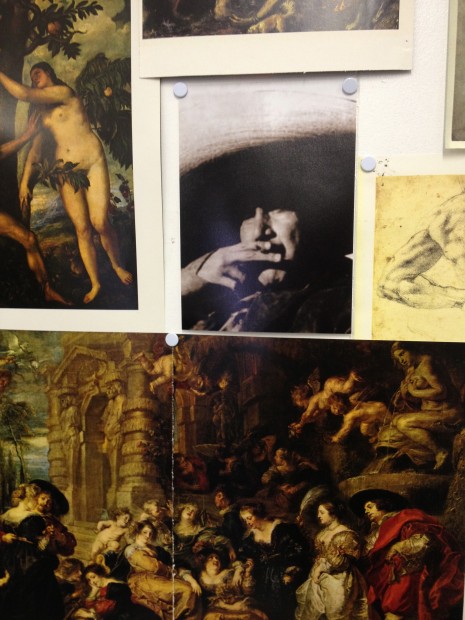
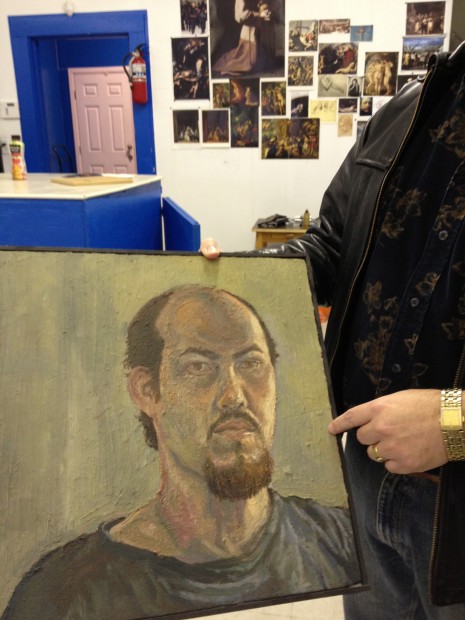
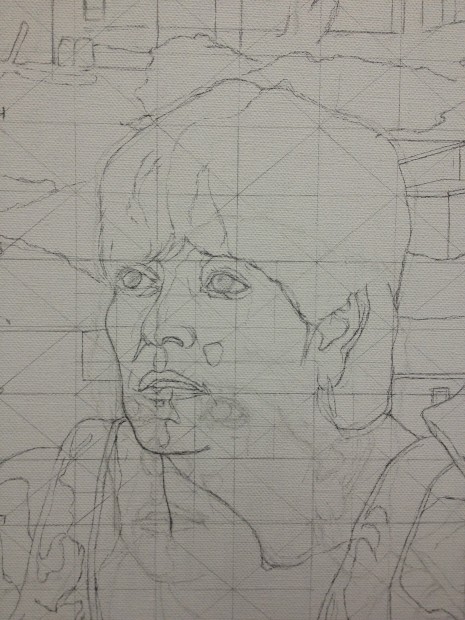
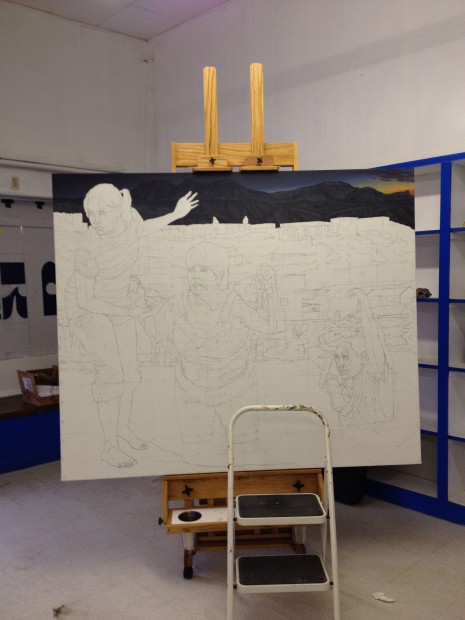
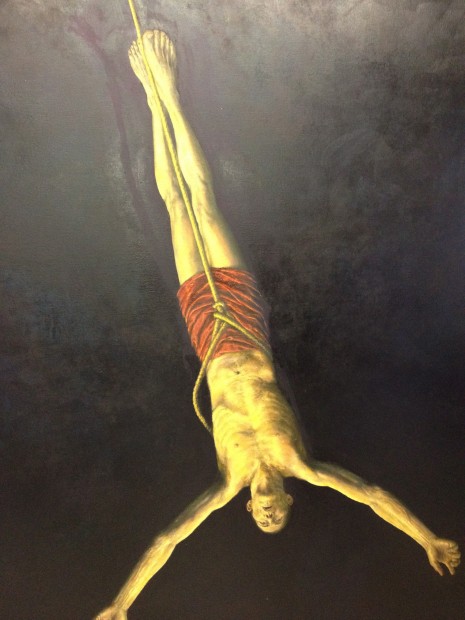

8 comments
This is great. Thanks for such an in-depth interview and narrative. Looking forward to reading more…
Mark your calendar for a solo exhibition by Rigoberto Gonzalez at the Southwest School of Art in San Antonio – September 5 – November 10, 2013.
Terrific!!!!
Thx Sarah!
Very enjoyable, you def captured his personality and
I like how you captured the essence of your exchange!
Houston has been lucky to have Large scale paintings at Art League Houston and his smaller scale artworks at TBHcenter.org by this phenom artist.
Packing up the works now – I believe it travels to Austin next – then SA!
Love this Sarah.. thank you for introducing me to this amazing artist in such an in-depth and entertaining way!!
I enjoyed this article / interview too Sarah !!!!
Great theme, great presentation and entertaining as well.
Good luck with the project ongoing.
Thanks so much, y’all. I really enjoyed working on this. Correction, though: it was me who couldn’t remember “mockingbird,” which is sinsonte. Upon listening again to the interview I heard this, but forgot to correct it.
That’s in Part 2 though.